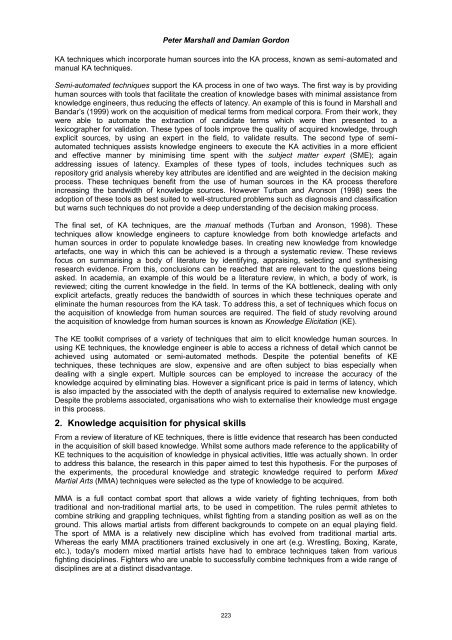Proceedings of the 3rd European Conference on Intellectual Capital
Proceedings of the 3rd European Conference on Intellectual Capital
Proceedings of the 3rd European Conference on Intellectual Capital
You also want an ePaper? Increase the reach of your titles
YUMPU automatically turns print PDFs into web optimized ePapers that Google loves.
Peter Marshall and Damian Gord<strong>on</strong><br />
KA techniques which incorporate human sources into <str<strong>on</strong>g>the</str<strong>on</strong>g> KA process, known as semi-automated and<br />
manual KA techniques.<br />
Semi-automated techniques support <str<strong>on</strong>g>the</str<strong>on</strong>g> KA process in <strong>on</strong>e <str<strong>on</strong>g>of</str<strong>on</strong>g> two ways. The first way is by providing<br />
human sources with tools that facilitate <str<strong>on</strong>g>the</str<strong>on</strong>g> creati<strong>on</strong> <str<strong>on</strong>g>of</str<strong>on</strong>g> knowledge bases with minimal assistance from<br />
knowledge engineers, thus reducing <str<strong>on</strong>g>the</str<strong>on</strong>g> effects <str<strong>on</strong>g>of</str<strong>on</strong>g> latency. An example <str<strong>on</strong>g>of</str<strong>on</strong>g> this is found in Marshall and<br />
Bandar‟s (1999) work <strong>on</strong> <str<strong>on</strong>g>the</str<strong>on</strong>g> acquisiti<strong>on</strong> <str<strong>on</strong>g>of</str<strong>on</strong>g> medical terms from medical corpora. From <str<strong>on</strong>g>the</str<strong>on</strong>g>ir work, <str<strong>on</strong>g>the</str<strong>on</strong>g>y<br />
were able to automate <str<strong>on</strong>g>the</str<strong>on</strong>g> extracti<strong>on</strong> <str<strong>on</strong>g>of</str<strong>on</strong>g> candidate terms which were <str<strong>on</strong>g>the</str<strong>on</strong>g>n presented to a<br />
lexicographer for validati<strong>on</strong>. These types <str<strong>on</strong>g>of</str<strong>on</strong>g> tools improve <str<strong>on</strong>g>the</str<strong>on</strong>g> quality <str<strong>on</strong>g>of</str<strong>on</strong>g> acquired knowledge, through<br />
explicit sources, by using an expert in <str<strong>on</strong>g>the</str<strong>on</strong>g> field, to validate results. The sec<strong>on</strong>d type <str<strong>on</strong>g>of</str<strong>on</strong>g> semiautomated<br />
techniques assists knowledge engineers to execute <str<strong>on</strong>g>the</str<strong>on</strong>g> KA activities in a more efficient<br />
and effective manner by minimising time spent with <str<strong>on</strong>g>the</str<strong>on</strong>g> subject matter expert (SME); again<br />
addressing issues <str<strong>on</strong>g>of</str<strong>on</strong>g> latency. Examples <str<strong>on</strong>g>of</str<strong>on</strong>g> <str<strong>on</strong>g>the</str<strong>on</strong>g>se types <str<strong>on</strong>g>of</str<strong>on</strong>g> tools, includes techniques such as<br />
repository grid analysis whereby key attributes are identified and are weighted in <str<strong>on</strong>g>the</str<strong>on</strong>g> decisi<strong>on</strong> making<br />
process. These techniques benefit from <str<strong>on</strong>g>the</str<strong>on</strong>g> use <str<strong>on</strong>g>of</str<strong>on</strong>g> human sources in <str<strong>on</strong>g>the</str<strong>on</strong>g> KA process <str<strong>on</strong>g>the</str<strong>on</strong>g>refore<br />
increasing <str<strong>on</strong>g>the</str<strong>on</strong>g> bandwidth <str<strong>on</strong>g>of</str<strong>on</strong>g> knowledge sources. However Turban and Ar<strong>on</strong>s<strong>on</strong> (1998) sees <str<strong>on</strong>g>the</str<strong>on</strong>g><br />
adopti<strong>on</strong> <str<strong>on</strong>g>of</str<strong>on</strong>g> <str<strong>on</strong>g>the</str<strong>on</strong>g>se tools as best suited to well-structured problems such as diagnosis and classificati<strong>on</strong><br />
but warns such techniques do not provide a deep understanding <str<strong>on</strong>g>of</str<strong>on</strong>g> <str<strong>on</strong>g>the</str<strong>on</strong>g> decisi<strong>on</strong> making process.<br />
The final set, <str<strong>on</strong>g>of</str<strong>on</strong>g> KA techniques, are <str<strong>on</strong>g>the</str<strong>on</strong>g> manual methods (Turban and Ar<strong>on</strong>s<strong>on</strong>, 1998). These<br />
techniques allow knowledge engineers to capture knowledge from both knowledge artefacts and<br />
human sources in order to populate knowledge bases. In creating new knowledge from knowledge<br />
artefacts, <strong>on</strong>e way in which this can be achieved is a through a systematic review. These reviews<br />
focus <strong>on</strong> summarising a body <str<strong>on</strong>g>of</str<strong>on</strong>g> literature by identifying, appraising, selecting and syn<str<strong>on</strong>g>the</str<strong>on</strong>g>sising<br />
research evidence. From this, c<strong>on</strong>clusi<strong>on</strong>s can be reached that are relevant to <str<strong>on</strong>g>the</str<strong>on</strong>g> questi<strong>on</strong>s being<br />
asked. In academia, an example <str<strong>on</strong>g>of</str<strong>on</strong>g> this would be a literature review, in which, a body <str<strong>on</strong>g>of</str<strong>on</strong>g> work, is<br />
reviewed; citing <str<strong>on</strong>g>the</str<strong>on</strong>g> current knowledge in <str<strong>on</strong>g>the</str<strong>on</strong>g> field. In terms <str<strong>on</strong>g>of</str<strong>on</strong>g> <str<strong>on</strong>g>the</str<strong>on</strong>g> KA bottleneck, dealing with <strong>on</strong>ly<br />
explicit artefacts, greatly reduces <str<strong>on</strong>g>the</str<strong>on</strong>g> bandwidth <str<strong>on</strong>g>of</str<strong>on</strong>g> sources in which <str<strong>on</strong>g>the</str<strong>on</strong>g>se techniques operate and<br />
eliminate <str<strong>on</strong>g>the</str<strong>on</strong>g> human resources from <str<strong>on</strong>g>the</str<strong>on</strong>g> KA task. To address this, a set <str<strong>on</strong>g>of</str<strong>on</strong>g> techniques which focus <strong>on</strong><br />
<str<strong>on</strong>g>the</str<strong>on</strong>g> acquisiti<strong>on</strong> <str<strong>on</strong>g>of</str<strong>on</strong>g> knowledge from human sources are required. The field <str<strong>on</strong>g>of</str<strong>on</strong>g> study revolving around<br />
<str<strong>on</strong>g>the</str<strong>on</strong>g> acquisiti<strong>on</strong> <str<strong>on</strong>g>of</str<strong>on</strong>g> knowledge from human sources is known as Knowledge Elicitati<strong>on</strong> (KE).<br />
The KE toolkit comprises <str<strong>on</strong>g>of</str<strong>on</strong>g> a variety <str<strong>on</strong>g>of</str<strong>on</strong>g> techniques that aim to elicit knowledge human sources. In<br />
using KE techniques, <str<strong>on</strong>g>the</str<strong>on</strong>g> knowledge engineer is able to access a richness <str<strong>on</strong>g>of</str<strong>on</strong>g> detail which cannot be<br />
achieved using automated or semi-automated methods. Despite <str<strong>on</strong>g>the</str<strong>on</strong>g> potential benefits <str<strong>on</strong>g>of</str<strong>on</strong>g> KE<br />
techniques, <str<strong>on</strong>g>the</str<strong>on</strong>g>se techniques are slow, expensive and are <str<strong>on</strong>g>of</str<strong>on</strong>g>ten subject to bias especially when<br />
dealing with a single expert. Multiple sources can be employed to increase <str<strong>on</strong>g>the</str<strong>on</strong>g> accuracy <str<strong>on</strong>g>of</str<strong>on</strong>g> <str<strong>on</strong>g>the</str<strong>on</strong>g><br />
knowledge acquired by eliminating bias. However a significant price is paid in terms <str<strong>on</strong>g>of</str<strong>on</strong>g> latency, which<br />
is also impacted by <str<strong>on</strong>g>the</str<strong>on</strong>g> associated with <str<strong>on</strong>g>the</str<strong>on</strong>g> depth <str<strong>on</strong>g>of</str<strong>on</strong>g> analysis required to externalise new knowledge.<br />
Despite <str<strong>on</strong>g>the</str<strong>on</strong>g> problems associated, organisati<strong>on</strong>s who wish to externalise <str<strong>on</strong>g>the</str<strong>on</strong>g>ir knowledge must engage<br />
in this process.<br />
2. Knowledge acquisiti<strong>on</strong> for physical skills<br />
From a review <str<strong>on</strong>g>of</str<strong>on</strong>g> literature <str<strong>on</strong>g>of</str<strong>on</strong>g> KE techniques, <str<strong>on</strong>g>the</str<strong>on</strong>g>re is little evidence that research has been c<strong>on</strong>ducted<br />
in <str<strong>on</strong>g>the</str<strong>on</strong>g> acquisiti<strong>on</strong> <str<strong>on</strong>g>of</str<strong>on</strong>g> skill based knowledge. Whilst some authors made reference to <str<strong>on</strong>g>the</str<strong>on</strong>g> applicability <str<strong>on</strong>g>of</str<strong>on</strong>g><br />
KE techniques to <str<strong>on</strong>g>the</str<strong>on</strong>g> acquisiti<strong>on</strong> <str<strong>on</strong>g>of</str<strong>on</strong>g> knowledge in physical activities, little was actually shown. In order<br />
to address this balance, <str<strong>on</strong>g>the</str<strong>on</strong>g> research in this paper aimed to test this hypo<str<strong>on</strong>g>the</str<strong>on</strong>g>sis. For <str<strong>on</strong>g>the</str<strong>on</strong>g> purposes <str<strong>on</strong>g>of</str<strong>on</strong>g><br />
<str<strong>on</strong>g>the</str<strong>on</strong>g> experiments, <str<strong>on</strong>g>the</str<strong>on</strong>g> procedural knowledge and strategic knowledge required to perform Mixed<br />
Martial Arts (MMA) techniques were selected as <str<strong>on</strong>g>the</str<strong>on</strong>g> type <str<strong>on</strong>g>of</str<strong>on</strong>g> knowledge to be acquired.<br />
MMA is a full c<strong>on</strong>tact combat sport that allows a wide variety <str<strong>on</strong>g>of</str<strong>on</strong>g> fighting techniques, from both<br />
traditi<strong>on</strong>al and n<strong>on</strong>-traditi<strong>on</strong>al martial arts, to be used in competiti<strong>on</strong>. The rules permit athletes to<br />
combine striking and grappling techniques, whilst fighting from a standing positi<strong>on</strong> as well as <strong>on</strong> <str<strong>on</strong>g>the</str<strong>on</strong>g><br />
ground. This allows martial artists from different backgrounds to compete <strong>on</strong> an equal playing field.<br />
The sport <str<strong>on</strong>g>of</str<strong>on</strong>g> MMA is a relatively new discipline which has evolved from traditi<strong>on</strong>al martial arts.<br />
Whereas <str<strong>on</strong>g>the</str<strong>on</strong>g> early MMA practiti<strong>on</strong>ers trained exclusively in <strong>on</strong>e art (e.g. Wrestling, Boxing, Karate,<br />
etc.), today's modern mixed martial artists have had to embrace techniques taken from various<br />
fighting disciplines. Fighters who are unable to successfully combine techniques from a wide range <str<strong>on</strong>g>of</str<strong>on</strong>g><br />
disciplines are at a distinct disadvantage.<br />
223
















